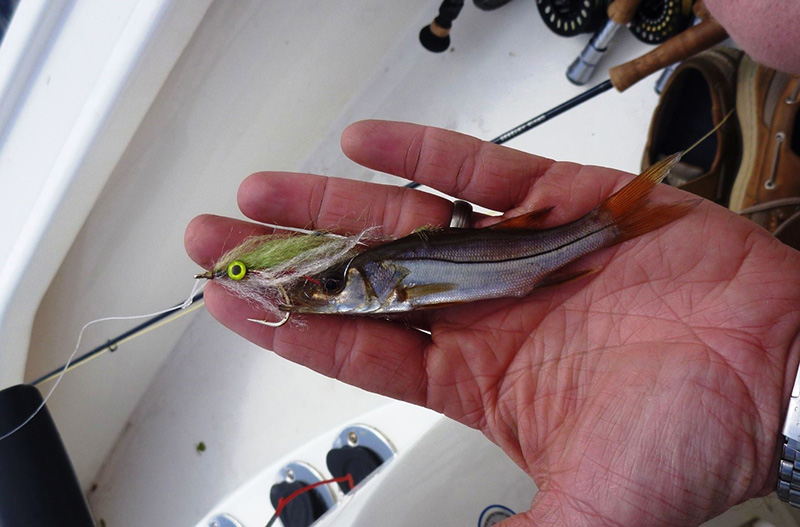
'The Fraternity of Fly Fishers'
May 05, 2014

"The surf: certainly one of nature's finest edges." Russell Chatham, Dark Waters [1988]

Some salt water fish are small – R. Travis Image
 The hatch and presence of Mahogany (Genus Paraleptophlebia) is totally overshadowed by those of Pale Morning Dun as they share just about the same hatch period. The Mahogany duns surely are beautiful mayflies too. Trout may not particularly key only on them but I often find them in stomach samples. It doesn't hurt to keep some of Mahogany patterns in your fly boxes to show something different to the trout.
The hatch and presence of Mahogany (Genus Paraleptophlebia) is totally overshadowed by those of Pale Morning Dun as they share just about the same hatch period. The Mahogany duns surely are beautiful mayflies too. Trout may not particularly key only on them but I often find them in stomach samples. It doesn't hurt to keep some of Mahogany patterns in your fly boxes to show something different to the trout.
 The chest-high weeds were thick and held the heat to an oppressive level as I pushed my way towards the edge of the water. The pinelands of southern New Jersey in late September can get hot, and this week was no exception. I had stumbled on a small spring-fed pothole while scouting for archery season a few weeks prior, and had promised myself to check it out with the fly rod.
The chest-high weeds were thick and held the heat to an oppressive level as I pushed my way towards the edge of the water. The pinelands of southern New Jersey in late September can get hot, and this week was no exception. I had stumbled on a small spring-fed pothole while scouting for archery season a few weeks prior, and had promised myself to check it out with the fly rod.
 It was a nice warm day with the highest temperature of the year so far. It seemed like a good time to hit the pond, and the next two days might have rain. I set up two 5 weight rods before leaving home. I tied on a yellow PTN and a hare's ear type fly made from Icelandic horse hair. This second fly is very rough and traps some air. Both of these flies had some fine wire wrapped on the hook before tying the fly. This would help them to drop some.
It was a nice warm day with the highest temperature of the year so far. It seemed like a good time to hit the pond, and the next two days might have rain. I set up two 5 weight rods before leaving home. I tied on a yellow PTN and a hare's ear type fly made from Icelandic horse hair. This second fly is very rough and traps some air. Both of these flies had some fine wire wrapped on the hook before tying the fly. This would help them to drop some.
![]() The Christmas holiday in 2013 took me from my winter digs in Florida to the frozen North Country of Monroe, New York. The purpose was to visit my son Ryan and his wife Lindsey who are Captains in the Army stationed West Point Military Academy as Tactical Officers. Of course my wife will tell you that the main reason for the visit was to spend time with our Grandson Skyler who graced the cover of this on-line magazine last year.
The Christmas holiday in 2013 took me from my winter digs in Florida to the frozen North Country of Monroe, New York. The purpose was to visit my son Ryan and his wife Lindsey who are Captains in the Army stationed West Point Military Academy as Tactical Officers. Of course my wife will tell you that the main reason for the visit was to spend time with our Grandson Skyler who graced the cover of this on-line magazine last year.
 Like most trout fishermen, I fish the major hatches on most any river I'm on, but I am most fond of 'caddis' fishing. The insects are on the water most any time of the year. My fly box(s) contains a variety of pattern styles, sizes and colors. That's the problem … I carry so many caddis patterns that I'm overwhelmed! The last few years I have promised myself to reduce the number of caddis pattern in exchange for a fewer number that are more productive.
Like most trout fishermen, I fish the major hatches on most any river I'm on, but I am most fond of 'caddis' fishing. The insects are on the water most any time of the year. My fly box(s) contains a variety of pattern styles, sizes and colors. That's the problem … I carry so many caddis patterns that I'm overwhelmed! The last few years I have promised myself to reduce the number of caddis pattern in exchange for a fewer number that are more productive.
 For the past twenty five years I have made trips to the saltwater, some of the trips were for just a couple of weeks, while others lasted for months. In 2008 my wife and I bought a place in Sebastian, Florida. Here I have the Indian River and Sebastian Inlet (Which is listed as one of the top ten fishing Inlets in the world) to fish, as well as the St. Sebastian River.
For the past twenty five years I have made trips to the saltwater, some of the trips were for just a couple of weeks, while others lasted for months. In 2008 my wife and I bought a place in Sebastian, Florida. Here I have the Indian River and Sebastian Inlet (Which is listed as one of the top ten fishing Inlets in the world) to fish, as well as the St. Sebastian River.
 With many anglers getting ready to head out for the first fishing trip of the year it's a good time to remind ourselves about proper methods for catching and releasing our quarry alive. Now if you are not into catch and release then you can skip this article, but I know that many anglers, especially trout anglers, release the majority of the fish that they catch. These are a few rules that will help insure that the fish you release will live to be caught another day.
With many anglers getting ready to head out for the first fishing trip of the year it's a good time to remind ourselves about proper methods for catching and releasing our quarry alive. Now if you are not into catch and release then you can skip this article, but I know that many anglers, especially trout anglers, release the majority of the fish that they catch. These are a few rules that will help insure that the fish you release will live to be caught another day.
![]() As a fly tier I am always looking for new and innovative books that deal with the art and science of fly constructions, and after reading the reviews of Feather Brain penned by such notable author/fly tier's as Eric Leiser, Dan Blanton and Jonny King I knew that I had to obtain a copy of the book.
As a fly tier I am always looking for new and innovative books that deal with the art and science of fly constructions, and after reading the reviews of Feather Brain penned by such notable author/fly tier's as Eric Leiser, Dan Blanton and Jonny King I knew that I had to obtain a copy of the book.
 One of my favorite cabin recipes which I enjoy usually enjoy just after rabbit season opens in the fall. It's normally served with wild rice, sautéed mushrooms and your favorite wine.
One of my favorite cabin recipes which I enjoy usually enjoy just after rabbit season opens in the fall. It's normally served with wild rice, sautéed mushrooms and your favorite wine.
[ HOME ]
[ Search ] [ Contact FAOL ] [ Media Kit ]